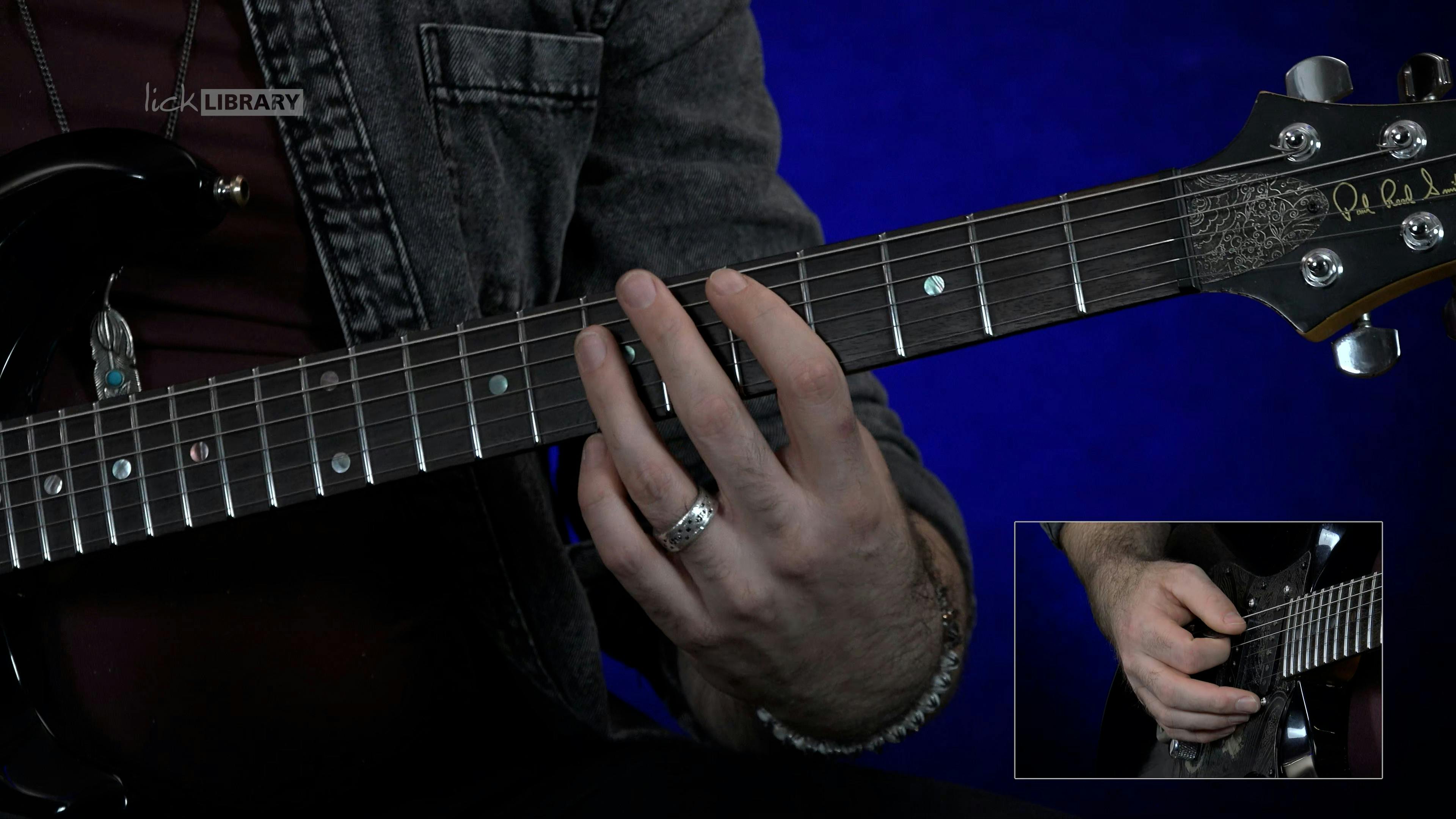Purchase options
* Online stream purchase has playback speed and looping control options
Watch course previewAccess every Licklibrary course
Alternatively you can instantly watch this course and all other courses in our Store with a Licklibrary membership more info
Black Sabbath – Black Sabbath
When Black Sabbath released their self-titled debut in 1970, the world of guitar-driven music changed forever. For many, this record marks the birth of heavy metal, and while the raw production might sound primitive compared to modern standards, the guitar work of Tony Iommi is nothing short of revolutionary. His riffs, scales, and solo phrasing laid the blueprint for countless sub-genres to come.
This breakdown is written with guitarists in mind—covering the scales, chord progressions, soloing approaches, and techniques that define this album. We’ll analyse each track, then reflect on Iommi’s overall contribution and lasting influence. Danny Gill breaks down this classic album in this exclusive Lick Library video course.
Tony Iommi: The Architect of Heavy Metal Guitar
Before diving into the tracks, it’s worth understanding Tony Iommi’s unique approach. After losing the tips of two fingers in a factory accident, Iommi adapted by crafting thimble-like prosthetics and tuning down his guitar (a practice that later became common in metal) to ease string tension. This adaptation not only shaped his sound but also inadvertently gave birth to the dark, sludgy tonalities that became synonymous with Black Sabbath.
Iommi’s playing blends blues phrasing with classical-inspired riffs, often relying on minor pentatonic, natural minor, and chromaticism. His solos are rarely about speed; instead, they focus on phrasing, bends, sustain, and emotive vibrato, which makes them timeless.
Track-by-Track Analysis
1. Black Sabbath
The album opener, and perhaps the most influential riff in heavy music. The main riff is essentially a tritone interval (root to flat fifth), sometimes referred to as the “Devil’s Interval.” Played slowly with ringing power chords, this progression set the tone for doom metal decades ahead.
- Scales Used: The riff draws from G natural minor with chromatic movement (G–G♯–A).
- Solo: The solo is bluesy, with string bending and slides dominating. Iommi employs the G minor pentatonic scale but decorates it with chromatic passing notes, giving the solo a haunting, almost unstable character.
- Techniques: Heavy reliance on sustain and vibrato.
This track was groundbreaking for its space—rather than filling every moment with sound, Iommi lets the riffs breathe, creating tension through silence as much as distortion.
2. The Wizard
Opening with a harmonica riff, this track quickly shifts into a boogie-driven blues rock piece, showcasing Iommi’s ability to swing.
- Scales Used: Primarily E blues scale (E–G–A–B♭–B–D).
- Riffs: The riffs use open-string riffs and a shuffling syncopated rhythm, almost like sped-up Cream or John Mayall.
- Solo: Iommi leans into hammer-ons and pull-offs, blending fast legato runs with bluesy bends. He alternates between rapid-fire licks and slower bends, building tension before resolving back into the groove.
This song shows the band’s deep blues roots but played heavier and with more grit than their contemporaries.
3. Behind the Wall of Sleep
This track is an early example of riff-based composition, where the riff itself drives the song more than the chord progressions.
- Scales Used: Mostly E minor pentatonic with chromatic passing tones.
- Riffs: Built around power chords and single-note runs, the main riff has a hypnotic quality.
- Solo: A tight solo emphasising phrasing over speed. Lots of minor third bends and trills (link) add a sinister vibe.
The groove is held together by palm-muting and simple, crushingly heavy guitar lines.
4. N.I.B.
Perhaps the most famous track on the album (next to the title track), “N.I.B.” features one of Iommi’s all-time greatest riffs.
- Scales Used: Rooted in E minor pentatonic but expanded with bluesy chromaticism.
- Riffing: The intro bass solo leads into a massive guitar riff, combining power chords with slides. The riff has a proto-doom feel, yet still grooves.
- Solo: Classic Iommi—phrases built from the E minor pentatonic, employing expressive string bending, double-stops, and a touch of chromaticism. His use of bluesy bends creates drama without needing high speed.
This song’s riff became a cornerstone of metal guitar vocabulary.
5. Evil Woman
A cover of Crow’s tune, “Evil Woman” might feel out of place to some, but it shows Sabbath’s roots in late ’60s hard rock.
- Scales Used: Primarily E minor pentatonic and Dorian mode.
- Riffs: Straightforward barre chord-driven rock riffing, with a slightly lighter tone compared to the originals.
- Solo: Iommi spices up the solo with hammer-ons, pull-offs, and wide vibrato. It’s blues-rock soloing with a heavier hand.
Though not as iconic as the originals, it highlights Iommi’s ability to take a straightforward rock song and make it heavier.
6. Sleeping Village
Opening with an eerie acoustic intro (using finger-picking), this track transitions into sludgy riffing that foreshadows stoner and doom metal.
- Scales Used: C♯ minor with modal shifts.
- Riffs: The main riff is slow, heavy, and drenched in distortion, showcasing early Sabbath’s proto-doom identity.
- Solo: Built from C♯ minor pentatonic, emphasising sustain and expressive bends. Iommi uses space effectively, allowing each note to linger.
This track feels experimental and atmospheric, proving Sabbath wasn’t just about straightforward riffing.
7. Warning
At over 10 minutes, this extended jam shows Sabbath’s roots in blues improvisation.
- Scales Used: Primarily A minor pentatonic.
- Solo: This is Iommi’s showcase. He explores every corner of the fretboard with string bending, slides, double-stops, and fast alternate picking. His phrasing is bluesy but with a darker, heavier edge.
- Techniques: A mix of legato, trills, and chromaticism. The use of sustain here is critical—notes ring out with an almost vocal-like intensity.
Though rooted in blues, the sheer heaviness of the tone separates it from Cream or Hendrix jams, marking new ground.
Conclusion: Iommi’s Lasting Contribution
With Black Sabbath, Tony Iommi didn’t just write riffs—he rewrote the rules of guitar playing. His use of downtuning, tritones, power chords, and heavy sustain created a sonic palette that defined metal. For guitarists, this album remains essential listening because it bridges blues traditions with the birth of something entirely new.
Guitar Techniques Used on Black Sabbath
Below is a list of techniques featured on the album, with links for guitarists wanting to dive deeper:
Features multi-angle high quality video lessons


All of our courses feature multiple camera angles, and online versions (lifetime streaming access and membership) additionally featured optimised device delivery, variable playback speeds and looping controls to make your learning experience even better!
Get more with a Licklibrary membership
- 1,000s of courses and lessons available to stream
- Exclusive new lessons every month
- Exclusive backing track library
- Access to every lesson and course
Technical Details
-
Code
RDR0626
-
Artist
Black Sabbath
-
Media
Online Stream, Download, 2x DVD Set
-
Media format
PAL Only
-
Genre
Metal, Classic Metal
-
Skill level
Easy, Suitable For All
-
EIN No
5060088826782
-
TAB NOT Included
-
NB: If purchasing as 'DVD', please ensure that your DVD player fully supports the 'Media format' (PAL Only) that this product is available in, as indicated above.

About The Tutor
Tutor Profile
Danny Gill
Danny Gill is, without a doubt, the most loved tutor by our community. With an incredible array of DVDs and web lessons for LickLibrary covering a wide variety of topics all of which he covers with incredible detail, it's no wonder he carries as much respect as he does. As...